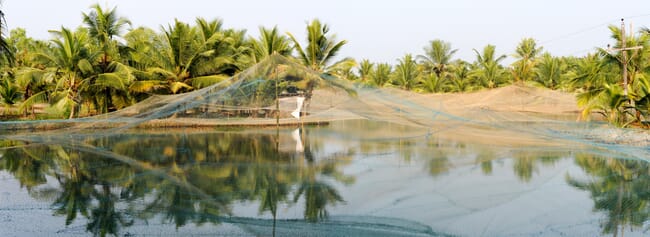So suggest the authors of a recent study which looked into how stocking ponds with finfish, instead of leaving them fallow, between cycles could generate income for farmers, reduce disease risk and leave them less open to the threat of shrimp-related disease outbreaks.

As the researchers note: “Shrimp farming is displaying spectacular growth in India by striking exports at an all-time high of $7.08 billion during the financial year 2017–18. However, sole dependence on a single species in monoculture system is not so much advisable as the country had well witnessed the catastrophe of Penaeus monodon…. Diversification of species and culture systems and an even distribution of production could provide resilience in the face of a changing climate and other external drivers and add economic, social and ecological insurance to aquaculture systems.”
The researchers also note that diversification and crop rotation, which they refer to as “intercropping”, can help reduce disease risks, while still allowing the farmers to be productive, rather than instigating a fallow period.
As they explain: “The practice of leaving the shrimp farm fallow for a season is known as crop holidays and are used as a preventive measure against host-specific viral disease. Intercrop with finfish could be an alternative for crop holidays in order to reduce the build-up of host-specific viral pathogens of shrimps without compromising the economics of the enterprise.”
Indeed, as they observe, in Gujarat, the “majority of the upcoming farms in the region are of small to medium size (0.25 to 5 hectares) restricted to a culture period of six to seven months with a maximum of two crop harvest, leaving the farm fallow for around five to six months. Considering the duration of two months required for pond drying, plowing, and other pond management for the new season, there still exists a three to four months window for possible rearing of animals. This three to four-month window can be utilized for an intercrop of the finfish which would not only ensure the elevated farm income but also ensure sustainability.”
In order to test this theory the researchers monitored the growth, survival and economic viability of growing silver pompano (Trachinotus blochi) – a species that has wide environmental tolerance, fast growth, good market and a standardized seed production technology.
And they concluded that: “Pompano has exhibited its sturdiness and adaptability to the land-based culture system as evidenced by an overall survival percentage of 89.8 including nursery and grow-out phases. The realized feed conversion ratio was 1.94. The culture period of 100 days is found to be enough to attain a desirable harvest size of 250 g. The projected production potential of the experimental demonstration farm of 4500 m2 water spread area for culture was 16.2 tonnes/cycle with a benefit-cost ratio (BCR) of 1.34 over operational cost. The present participatory trial empirically proved the viability of silver pompano as an intercrop in coastal shrimp ponds. Thus, the introduction of pompano in shrimp ponds is recommended and can be promoted for sustainable intercropping with shrimp farming along the Indian coast for improving people’s livelihoods.
The full study, Intercropping of marine finfish in shrimp ponds: A maiden feasibility study, by Dr Divu Damodaran et al, can be accessed here.




